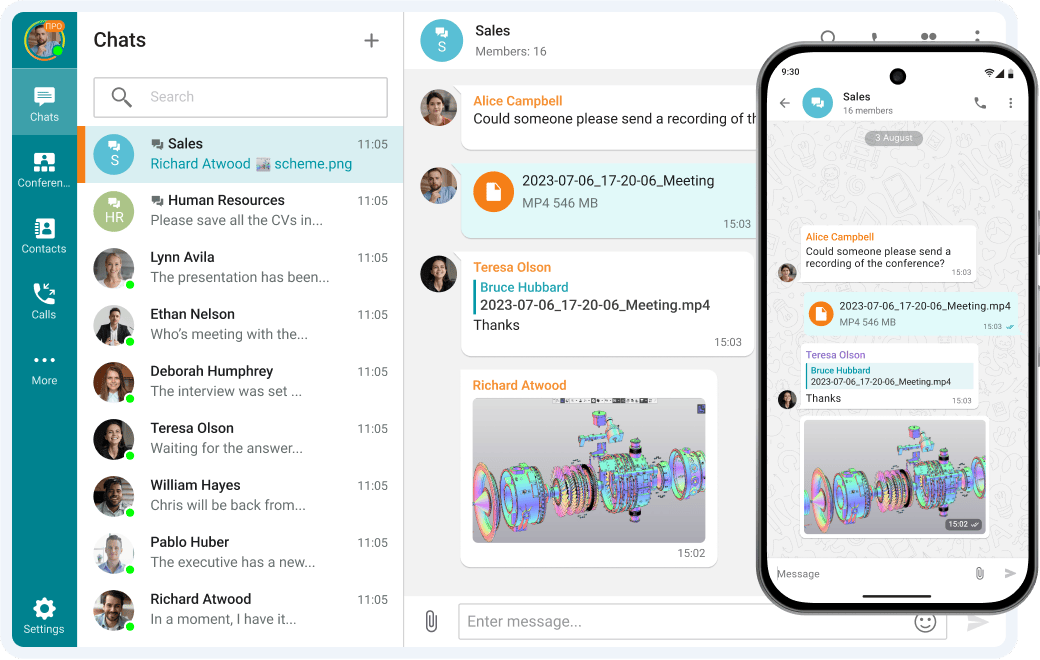Asynchronous Messaging: What It Is, Why It Matters, and How It’s Used in Customer Support, IoT, and Microservices
Asynchronous messaging significantly transforms the way companies interact and develop their platforms. It allows users to transmit and collect information without requiring instant feedback or simultaneous presence.
This guide will describe how asynchronous messaging operates, why it contrasts with classic synchronous interaction, and how it plays a key role in modern client service, smart devices (IoT), and modular software systems.
What is Asynchronous Messaging?
Asynchronous messaging remains an approach for digital interaction where each device or individual transfers information, while another component accesses it afterward. Constant presence or immediate connection is not required.
In most cases, information travels via a method such as a data queue or transfer mechanism. That method stores the data and routes it toward the correct destination when the recipient becomes active. The originator avoids delays waiting for acknowledgment and continues managing different actions immediately. The data remains queued until the receiving end is available to process it.
Modern applications often rely on a platform known as a data broker or handler. The source sends content to this broker, which ensures reliable transmission to the intended party. The recipient can issue a follow-up message, but that answer might also be delayed.
One everyday illustration is email: a person delivers a message, and the recipient may view and respond at a much later moment. In digital systems, technologies such as Kafka or RabbitMQ function similarly. They hold messages and release them once the receiving component is ready.
Asynchronous vs. Synchronous Messaging
Asynchronous messaging contrasts with synchronous messaging (like a phone call or a direct API call) where the communication happens in real-time. Below are key differences between asynchronous and synchronous messaging:
| Aspect | Synchronous Messaging | Asynchronous Messaging |
|---|---|---|
| Communication Timing | Requires both the sender and receiver to be available at the same time. The sender waits for an immediate response. | Sender sends the message and moves on. The receiver can respond later. Communication can span pauses and resume anytime. |
| Reliability & Resilience | Fails if receiver is unavailable. No message delivery if one party is offline. | Uses queues/storage. Messages persist until receiver is ready. Tolerates outages and ensures delivery without data loss. |
| Scalability | Resources are tied up waiting for responses. Can become bottlenecked under high load. | Sender and receiver operate independently. Services scale separately. More efficient for high-volume environments. |
| User Experience | Immediate responses possible but users may face wait times (e.g. being on hold or in chat queues). | No need to wait for live response. Users send and receive messages at their convenience, with context preserved. |
Benefits of Asynchronous Messaging
Adopting asynchronous messaging often delivers valuable improvements across platforms and organizations. Notable benefits include:
Scalability: Since transmitters and handlers operate independently, every segment within the architecture can expand or reduce when required. For instance, as additional traffic arrives, extra processors may assist with processing — without affecting the transmission structure. To further support scalability and prevent overload, techniques like Response Rate Limiting help control the rate of incoming messages, ensuring the system maintains balance and efficiency.
Performance and Throughput: Asynchronous messaging helps applications maintain activity while avoiding delays from responses. This boosts efficiency and enhances operation. In online environments, this translates into quicker feedback for users while background tasks continue processing.
Flexibility in Integration: Separate modules inside a platform can link more smoothly, regardless of their coding language or deployment location. Because coordination doesn’t rely on timing, developers independently maintain or improve services, which speeds updates and reduces effort.
Improved User Experience: Customers aren’t forced to remain online awaiting answers. They may transmit questions and return later for replies. This becomes especially useful in support systems where staff provide informed answers and clients avoid unnecessary pressure.
System Resilience: Messages remain protected until retrieval is possible. If a segment goes offline or suffers failure, essential data remains intact. Operations resume normally, and once active, receivers handle pending tasks. This minimizes disruptions and supports system stability.
Challenges of Asynchronous Messaging
Although asynchronous messaging brings strong advantages, it also creates specific obstacles and added complexity that companies must handle carefully:
Message Ordering: Within asynchronous frameworks, information could be received or handled out of the original sequence. If proper order is critical l— such as during transaction updates or database synchronization — developers must include features like tracking IDs or systems that enforce processing sequence reliably.
Delivery Guarantees: Ensuring dependable transmission (while preventing missed or repeated content) becomes a major priority. Many platforms support at-least-once delivery (retries occur until confirmation, which may cause repeated handling) or at-most-once delivery (no duplicates, but some data may be skipped during faults). Reaching exactly-once execution remains complex. Engineers need to include tools like receipt confirmations, timed retries, and duplicate-safe functions to manage delivery safely.
Complexity: Adding asynchronous communication introduces additional infrastructure — such as queues, brokers, or services — that may fail or impact performance. Maintaining these elements takes effort. Also, developing for asynchronous flow is harder than basic direct calls. Builders must prepare for delayed answers and maintain logical accuracy, which increases development time and testing needs.
Monitoring and Debugging: In synchronous systems, tracking a request’s journey is direct. But in asynchronous setups, one task could trigger multiple delayed messages across separate systems, making tracking more difficult. Without solid tracing and monitoring tools, problems may go unnoticed. Teams often apply techniques like correlation IDs and end-to-end tracing systems to map messages through their full path — but this setup adds complexity and demands strategic preparation.
Use Cases of Asynchronous Messaging
Asynchronous messaging is used across various domains to solve real-world problems. Below are a few key use cases demonstrating its value in different contexts.
Asynchronous Messaging in Customer Service
Modern support teams regularly adopt asynchronous tools — such as chat, SMS, email, WhatsApp, or embedded messaging or 24/7 answering services — where users aren’t expected to answer immediately. This improves the overall service quality and efficiency.
People no longer stay stuck on hold or leave chat sessions open endlessly. Instead, they submit questions and return later. AI phone agents respond once available, allowing the exchange to move at the customer’s own speed. This kind of timing control adds major convenience. Few businesses also use an AI voice agent to handle routine voice queries asynchronously, giving customers another channel that doesn’t require waiting on hold.
Support teams benefit too. They manage several conversations by shifting focus while waiting between replies. Unlike phone-based service — where each worker speaks with just one caller — async messaging enables multitasking. Additionally, if users leave and return later, they resume easily, as message history remains intact, avoiding repeated explanations.
This model often increases satisfaction. For instance, Spartan Race implemented asynchronous communication and achieved a 90% positive rating, using only 75 representatives to resolve 36,000 inquiries monthly. The ability to handle multiple chats while keeping customers free from wait times boosts both efficiency and user experience.
Asynchronous Messaging in IoT
Within the Internet-connected environment of IoT (Internet of Things), asynchronous messaging plays a crucial role. Numerous IoT devices—such as monitors, home appliances, or distant equipment—may not remain active constantly. They may rely on limited power or unstable connectivity, which prevents continuous data transfer or reception.
This is where asynchronous messaging provides a solution. Devices transmit information whenever possible, while the platform captures and stores it — even during server downtime. The content is held securely and sent again after connections return. This ensures nothing important disappears due to outages or sleep cycles.
Such messaging fits naturally into event-driven architectures, commonly used in IoT. Devices regularly push signals — like heat readings or motion triggers. Rather than polling frequently (which consumes energy), systems rely on lightweight protocols like MQTT to reduce strain.
MQTT enables devices to publish messages to a central hub, allowing other components to fetch updates as needed. This separation between data sources and receivers enhances both the scalability and the adaptability of the system.
For instance, when a smart thermostat sends status reports to the cloud, dropped connections won’t disrupt the process. The messages are held and forwarded later. This design scales smoothly — even across millions of devices with spotty connections. Asynchronous messaging guarantees eventual delivery, which is typically all that’s needed for most IoT scenarios.
Asynchronous Messaging in Microservices
Within microservices architectures, multiple modular and independent units must interact seamlessly. Asynchronous messaging enables these components to exchange information without creating tight links between them.
Rather than having one module call another and pause for feedback, each service may dispatch a message or signal and continue working. This design allows individual services to operate and expand independently.
Take an online marketplace, for instance: when a purchase happens, the ordering component can broadcast an “Order Placed” notification. Other units—such as inventory, payments, or alerts—can monitor that signal and perform their roles (like updating stock, processing charges, or emailing users) at their own pace. The ordering function proceeds without delays.
This approach increases adaptability and system reliability. When one part slows down or disconnects, its messages wait in storage until they can be processed. A single issue won’t crash the whole application.
Growth is straightforward, too. If traffic spikes, extra instances of the overloaded component can be added to manage the message flow. Adding features is equally simple. A new service — such as one logging transactions for insights — can subscribe to the existing “Order Placed” message, avoiding any changes to the current setup.
Examples of Asynchronous Messaging
Asynchronous communication plays a regular role in modern routines—so widespread that individuals may rarely realize it’s happening. In contrast to real-time dialogue, these methods support interaction without requiring both participants to engage simultaneously. This provides a more seamless, adaptable process, particularly in dynamic or distributed settings where immediate replies may not be practical.
Among the most established and widely trusted formats of asynchronous exchange. A person composes a message, then the recipient reviews and answers at a later stage—possibly within minutes, hours, or even several days. Email remains common in corporate, academic, and casual communication. It accommodates files, redirection, and threaded sequences, which makes it a strong option for less urgent or well-organized conversations.
Text Messages (SMS)
SMS enables fast content transmission that doesn’t depend on real-time attention. The message receiver can respond whenever they are free. Unlike traditional phone conversations, SMS avoids disruption, providing a more considerate and lightweight channel for delivering short alerts or friendly reminders.
Messenger Apps (e.g., WhatsApp, Telegram, Signal)
Contemporary messaging software enhances asynchronous communication with additional functionality. These platforms allow users to send:
- Written content
- Audio messages
- Visual media
- Documents and links
- Location data
- Emoji
Many of these tools feature group functionality, persistent chat logs, and adjustable alert preferences, making it easier to handle ongoing conversations. They are ideal for hybrid teams, global partners, and customer service situations where synchronized contact is not guaranteed.
Support Ticket Systems
Help desk solutions such as Zendesk or Freshdesk, or internal IT portals let customers create queries that are reviewed and answered later by support staff. Each interaction is stored with identifiers, timestamps, and categories for clarity. This asynchronous workflow minimizes idle waiting, boosts agent throughput, and maintains accurate records—ultimately enhancing both service delivery and operational flow. Incorporating solutions like queue management software can further streamline operations efficiently.
Workplace Messaging Tools

Platforms including Slack, Microsoft Teams, and TrueConf enable well-structured communication between departments. With capabilities such as threaded replies, tag notifications, file exchange, and searchable logs, teams remain productive even without real-time coordination. This becomes crucial for geographically spread workforces operating across different regions or schedules.
Take your team communication to the next level with TrueConf!
A powerful self-hosted video conferencing solution for up to 1,000 users, available on desktop, mobile, and room systems.
Conclusion
Asynchronous messaging serves as a key principle for creating scalable, distributed, and efficient systems. By separating the timing of senders and receivers, it allows systems to scale more easily, withstand interruptions, and offer flexibility that direct communication methods struggle to provide.
Its influence spans several domains: in customer service, it enhances response quality and speed; in IoT, it supports stable communication among large numbers of connected devices; and in microservices, it enables independent components to interact without tight interdependence.
Although these advantages introduce extra design demands, proper planning and reliable practices, such as defining message structures clearly, implementing smart retry strategies, maintaining system observability, and selecting suitable technologies, allow organizations to fully benefit from asynchronous messaging.
About the Author
Olga Afonina is a technology writer and industry expert specializing in video conferencing solutions and collaboration software. At TrueConf, she focuses on exploring the latest trends in collaboration technologies and providing businesses with practical insights into effective workplace communication. Drawing on her background in content development and industry research, Olga writes articles and reviews that help readers better understand the benefits of enterprise-grade communication.



Follow us on social networks